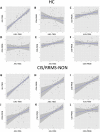Comparison of probabilistic tractography and tract-based spatial statistics for assessing optic radiation damage in patients with autoimmune inflammatory disorders of the central nervous system
- PMID: 29984162
- PMCID: PMC6029567
- DOI: 10.1016/j.nicl.2018.05.004
Comparison of probabilistic tractography and tract-based spatial statistics for assessing optic radiation damage in patients with autoimmune inflammatory disorders of the central nervous system
Abstract
Background: Diffusion Tensor Imaging (DTI) can evaluate microstructural tissue damage in the optic radiation (OR) of patients with clinically isolated syndrome (CIS), early relapsing-remitting multiple sclerosis and neuromyelitis optica spectrum disorders (NMOSD). Different post-processing techniques, e.g. tract-based spatial statistics (TBSS) and probabilistic tractography, exist to quantify this damage.
Objective: To evaluate the capacity of TBSS-based atlas region-of-interest (ROI) combination with 1) posterior thalamic radiation ROIs from the Johns Hopkins University atlas (JHU-TBSS), 2) Juelich Probabilistic ROIs (JUEL-TBSS) and tractography methods using 3) ConTrack (CON-PROB) and 4) constrained spherical deconvolution tractography (CSD-PROB) to detect OR damage in patients with a) NMOSD with prior ON (NMOSD-ON), b) CIS and early RRMS patients with ON (CIS/RRMS-ON) and c) CIS and early RRMS patients without prior ON (CIS/RRMS-NON) against healthy controls (HCs).
Methods: Twenty-three NMOSD-ON, 18 CIS/RRMS-ON, 21 CIS/RRMS-NON, and 26 HCs underwent 3 T MRI. DTI data analysis was carried out using JUEL-TBSS, JHU-TBSS, CON-PROB and CSD-PROB. Optical coherence tomography (OCT) and visual acuity testing was performed in the majority of patients and HCs.
Results: Absolute OR fractional anisotropy (FA) values differed between all methods but showed good correlation and agreement in Bland-Altman analysis. OR FA values between NMOSD and HC differed throughout the methodologies (p-values ranging from p < 0.0001 to 0.0043). ROC-analysis and effect size estimation revealed higher AUCs and R2 for CSD-PROB (AUC = 0.812; R2 = 0.282) and JHU-TBSS (AUC = 0.756; R2 = 0.262), compared to CON-PROB (AUC = 0.742; R2 = 0.179) and JUEL-TBSS (AUC = 0.719; R2 = 0.161). Differences between CIS/RRMS-NON and HC were only observable in CSD-PROB (AUC = 0.796; R2 = 0.094). No significant differences between CIS/RRMS-ON and HC were detected by any of the methods.
Conclusions: All DTI post-processing techniques facilitated the detection of OR damage in patient groups with severe microstructural OR degradation. The comparison of distinct disease groups by use of different methods may lead to different - either false-positive or false-negative - results. Since different DTI post-processing approaches seem to provide complementary information on OR damage, application of distinct methods may depend on the relevant research question.
Keywords: AD, axial diffusivity; AUC, area under the curve; CIS, clinically isolated syndrome; CON, Contrack; CSD, constrained spherical deconvolution; DTI; DTI, diffusion tensor imaging; DW-MRI, diffusion weighted magnetic resonance imaging; DWI, diffusion weighted imaging; FA, fractional anisotropy; FOD, fiber orientation distribution; HC, Healthy Control; JHU, Johns Hopkins University DTI white matter atlas; JUEL, Juelich histological atlas; LGN, lateral geniculate nucleus; MD, mean diffusivity; MS, multiple sclerosis; Multiple sclerosis; NMOSD, neuromyelitis optica spectrum disorder; Neuromyelitis optica; OCT, optical coherence tomography; ON, optic neuritis; OR, optic radiation; Optic radiation; PROB, probabilistic tractography; Probabilistic tractography; RD, radial diffusivity; RNFL, retinal nerve fiber layer thickness; ROC, receiver operating characteristic; ROI, region of interest; RRMS, relapsing-remitting multiple sclerosis; SD, standard deviation; SEM, standard error of the mean; TBSS; TBSS, tract-based spatial statistics.
Figures











Similar articles
-
Microstructural white matter abnormalities in multiple sclerosis and neuromyelitis optica spectrum disorders: Evaluation by advanced diffusion imaging.J Neurol Sci. 2022 May 15;436:120205. doi: 10.1016/j.jns.2022.120205. Epub 2022 Feb 24. J Neurol Sci. 2022. PMID: 35259556
-
Segmental abnormalities of white matter microstructure in multiple sclerosis and neuromyelitis optica spectrum disorder identified by automated fiber quantification.Mult Scler Relat Disord. 2024 Dec;92:106147. doi: 10.1016/j.msard.2024.106147. Epub 2024 Oct 29. Mult Scler Relat Disord. 2024. PMID: 39504730
-
Neurite orientation dispersion and density imaging in myelin oligodendrocyte glycoprotein antibody-associated disease and neuromyelitis optica spectrum disorders.Mult Scler Relat Disord. 2025 Mar;95:106324. doi: 10.1016/j.msard.2025.106324. Epub 2025 Feb 8. Mult Scler Relat Disord. 2025. PMID: 39955814
-
The role of diffusion tensor imaging and fractional anisotropy in the evaluation of patients with idiopathic normal pressure hydrocephalus: a literature review.Neurosurg Focus. 2016 Sep;41(3):E12. doi: 10.3171/2016.6.FOCUS16192. Neurosurg Focus. 2016. PMID: 27581308 Review.
-
Optical Coherence Tomography and Magnetic Resonance Imaging in Multiple Sclerosis and Neuromyelitis Optica Spectrum Disorder.Int J Mol Sci. 2016 Nov 15;17(11):1894. doi: 10.3390/ijms17111894. Int J Mol Sci. 2016. PMID: 27854301 Free PMC article. Review.
Cited by
-
Fixel-Based Analysis of White Matter Degeneration in Patients With Progressive Supranuclear Palsy or Multiple System Atrophy, as Compared to Parkinson's Disease.Front Aging Neurosci. 2021 Mar 16;13:625874. doi: 10.3389/fnagi.2021.625874. eCollection 2021. Front Aging Neurosci. 2021. PMID: 33815089 Free PMC article.
-
Anatomical and functional visual network patterns in progressive multiple sclerosis.Hum Brain Mapp. 2022 Apr 1;43(5):1590-1597. doi: 10.1002/hbm.25744. Epub 2021 Dec 20. Hum Brain Mapp. 2022. PMID: 34931352 Free PMC article.
-
Standardization of T1w/T2w Ratio Improves Detection of Tissue Damage in Multiple Sclerosis.Front Neurol. 2019 Apr 9;10:334. doi: 10.3389/fneur.2019.00334. eCollection 2019. Front Neurol. 2019. PMID: 31024428 Free PMC article.
-
Compromised Cerebello-Thalamic White Matter Integrity in Medication-Free Patients With Obsessive-Compulsive Disorder.Psychiatry Investig. 2023 Jun;20(6):550-558. doi: 10.30773/pi.2022.0334. Epub 2023 Jun 21. Psychiatry Investig. 2023. PMID: 37357670 Free PMC article.
-
Visualizing the Central Nervous System: Imaging Tools for Multiple Sclerosis and Neuromyelitis Optica Spectrum Disorders.Front Neurol. 2020 Jun 17;11:450. doi: 10.3389/fneur.2020.00450. eCollection 2020. Front Neurol. 2020. PMID: 32625158 Free PMC article. Review.
References
-
- Assaf Y., Pasternak O. Diffusion tensor imaging (DTI)-based white matter mapping in brain research: a review. J. Mol. Neurosci. 2008;34:51–61. - PubMed
Publication types
MeSH terms
LinkOut - more resources
Full Text Sources
Other Literature Sources
Miscellaneous

